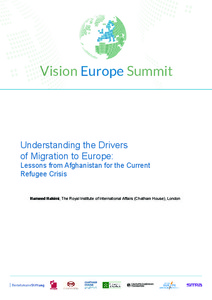Understanding the drivers of migration to Europe. Lessons from Afghanistan for the Current Refugee Crisis
"With record numbers of refugees arriving in Europe in 2015, the crisis facing European Union states has put pressure on policymakers to devise effective policy options that address both the plight of refugees and the concerns of EU citizens who feel overwhelmed by recent inflows. The European...
| Main Authors: | , |
|---|---|
| Institution: | ETUI-European Trade Union Institute |
| Format: | TEXT |
| Language: | English |
| Published: |
Gütersloh
2016
Bertelsmann Stiftung |
| Subjects: | |
| Online Access: | https://www.labourline.org/KENTIKA-014812483209-understanding-the-drivers-of-m.htm |
| Summary: | "With record numbers of refugees arriving in Europe in 2015, the crisis facing European Union states has put pressure on policymakers to devise effective policy options that address both the plight of refugees and the concerns of EU citizens who feel overwhelmed by recent inflows.
The European Council has placed migration at the top of the EU’s agenda, with efforts designed to help frontline member states with identification and asylum processes and control of the EU’s external borders; naval operations in the Mediterranean; temporary and emergency-driven relocation mechanism within the EU; and cooperation with source and transit countries through financial, technical and development assistance. Yet, the outcomes have been unsuccessful. Many argue that these actions fail to address the root causes driving people to seek safety in Europe. A complex network of push and pull factors explain why so many have left everything to seek safety within the EU.
To avoid hasty policy responses for better management of migration, it is important to understand what has and has not worked in the past. Examining other major countries of origin for refugees in Europe, in particular Afghanistan, can provide useful guidelines for current policy.
Syria, the current number one source country of refugees globally, has received humanitarian assistance from Europe with continued pledges of a multibillion-euro package from the EU in early 2016. Likewise Afghanistan received over €2.5 billion in EU assistance alone between 2002 and 2013. It also receives funding under EU regional programmes for Asia, in particular Aid for Uprooted People, as well as number of other thematic funding instruments.
However, this assistance has not stemmed the flow of refugees, with hundreds of thousands of Afghans continuing to flee their country for safety abroad, including in Europe. An estimated 550,000 Afghans are projected to seek refugee status in Europe by 2018. Recently, some Western embassies in Kabul, such as the German embassy, have launched information campaigns to dissuade Afghans from leaving their homeland.
Are there lessons for European policymakers from the intervention in Afghanistan since 2001? How are information campaigns working in an environment where migrants have access to extensive communication technology? This research looks at the case of Afghanistan as a ‘lessons learned’ example and highlights where European efforts to tackle the refugee crisis could be improved. The conclusions are relevant for Syria and other countries in which the EU has humanitarian engagement and from where refugees in Europe originate." |
|---|---|
| Physical Description: | 26 p. Digital |

